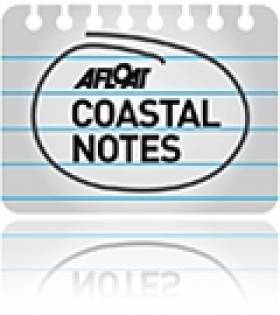Displaying items by tag: East Link 30th Anniversary
#EastLink@30 – Naval Service OPV L.E. Aisling (P23) took the honour of passing through Dublin's East-Link Toll Bridge as the Liffey road crossing celebrated opening to traffic 30 years ago today, writes Jehan Ashmore.
The final of the 'Emer' OPV class built sisters made the transit of the bridge built to a bascule design in which the 'lifting' span of 45 metres wide was raised. The opening span weighing 500 tons is tilted to 80 degrees and taking less than a minute to complete. This allowed the L.E Aisling to continue upriver to berth along Sir John Rogersons Quay.
When the bridge was opened on 21st October 1984, this created a new eastern by-pass of the capital however this was to be an end of era with the withdrawal of the Liffey ferry, albeit a foot-passenger only service.
The ferry was used as short cut mostly for 'dockers' as otherwise the next fixed link bridging the Liffey three decades ago was the Matt Talbot Memorial Bridge. This structure was close to where the last Guinness stout-ships berthed, The Lady Patricia and Miranda Guinness along Sir John Rogersons Quay.
The stout-tankers were the last ships to regularly transit the East-Link Bridge until 1993. They exported the 'black stuff' to Runcorn on the Manchester Ship Canal.
The East-Link Bridge has a strong commuter profile with approximately 17,500 vehicles daily using the bridge connecting the north and south quays. The bridge spanning 150 metres was the vision of Tom Roche (senior) founder of the National Toll Roads, the original operators of the tolled bridge.
Not only is the bridge used by car motorists but notably is a national strategic infrastructure asset for freight trucks to access the port. As the years passed with the opening of the Dublin Port Tunnel, this formed another key part of the overall port related road network and to further alleviate congestion away from the city-centre quays.
Another milestone in the infrastructure of bridging the Liffey was the Samuel Beckett Bridge which ironically itself made a transit through the East-Link Bridge. The structure was loaded on board a barge in The Netherlands and was towed to Dublin Port in 2009 for installation. The Samuel Beckett Bridge is of a swing-bridge design in which the whole bridge pivots on a single pier.
It was in May this year when another of the Naval Service's OPV's the newbuild L.E. Samuel Beckett (P61) moored close to the bridge also bearing the name of the playright as the vessel was christened along the south quays.
For a speeded up footage taken on board from the mast of the newbuild as she headed into Dublin Port and through the East-Link Bridge prior to her naming ceremony, click HERE.





























































